► An inside look at Mercedes’ plans for increased diversity in F1…
► And it’s more than just a black paint job
► What’s next?
We’re coming to the end of the strangest F1 season in modern times. Despite a modified calendar which has seen F1 visit some new and familiar tracks the results at the sharp end have been much like 2019. Hamilton has now surpassed Schumacher’s record of 91 wins, Mercedes is at the top of the constructors – and Max Verstappen is chasing both Silver Arrows in a lonely third. But it’s not just Coronavirus or Lewis’ record-breaking that has defined the 2020 championship.
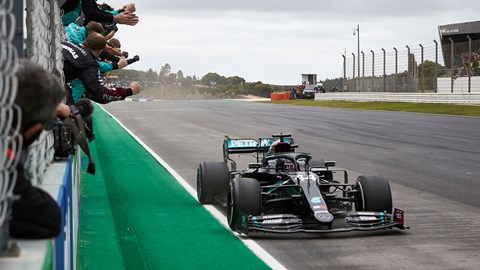
After a false start in Melbourne, the Formula One season began in Austria – around five months later than usual – but during the extended pre-season, events in America forced the world to re-examine its efforts in diversity, inclusion and equality.
The killing of George Floyd sparked riots in in cities across the US, but its effects have been felt across the globe, and throughout society. First personalities and sporting figures spoke up, then brands posted messages of solidarity on social media – and now almost every organisation has rushed to bolster or create a diversity and inclusion program.
Somewhat surprisingly, F1 hasn’t completely sat on its hands during this movement, and the pinnacle of motorsport has attempted to use its global platform to promote change. F1 itself has launched a rather ambiguous, tokenistic-looking #WeRaceAsOne campaign – and most drivers began to kneel before races – but the most obvious display of solidarity lies with Mercedes’ decision to paint its new challenger black – not traditional silver.
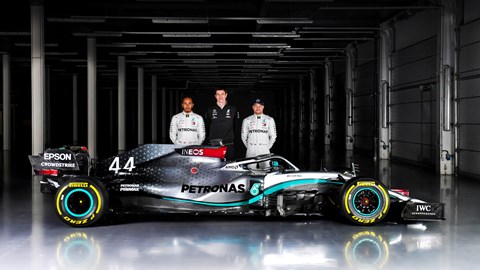
To find out the thinking behind the decision, what it actually means and how Mercedes – a team which is arguably at the peak of its powers – aims to change for the better, CAR spoke to the team’s communications director, Bradley Lord.
Where did it come from?
‘It put what was already an area of focus, higher up the agenda for the team and Lewis is very keen to see his leadership reflected by the team in this space, and the support in his advocacy,’ explains Lord. ‘I think the discussions that then happened with him, with Toto, and with our senior leadership led us to the point of making the commitment to not just make the overt statement of changing the livery of the car as a sort of messaging platform – but also to then put in place an ongoing commitment to back that gesture up with the measures and the actions that are required to actually drive meaningful change.’
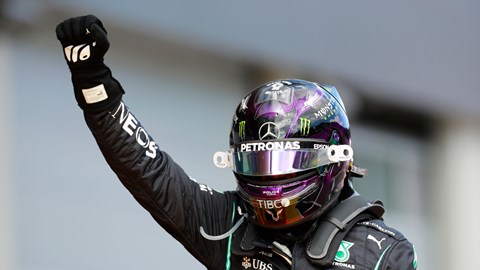
The awareness triggered by events in America, as well as dialogue with its star driver, led the Brackley outfit to evaluate its performance in an entirely different sector, and for once it came up short: Data released by the team revealed that of the total workforce, just 3% identified as minority groups, and just 12% were women.
It can’t have been a huge surprise: Hamilton is the first and only black driver to compete in its 75-year history, and the sport’s beginnings are rooted in English, usually well-off roots – for the most part.
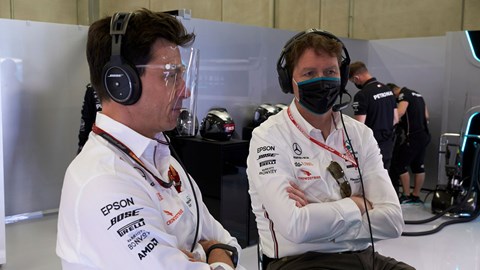
With those figures as context, the decision was taken to push for a more equal, diverse F1 team. ‘We wish to use our voice and our global platform to speak up for respect and equality, and the Silver Arrow will race in black for the entire 2020 season to show our commitment to greater diversity within our team and our sport,’ said Toto Wolff, team principal of Mercedes-AMG F1. ‘We will not shy away from our weaknesses in this area, nor from the progress we must still make; our livery is our public pledge to take positive action.’ he added.
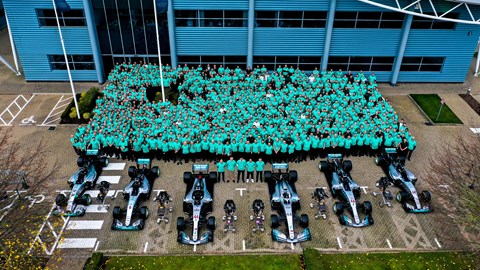
What does change look like?
Lord is keen to stress there that while the composition of the workforce isn’t ideal, the team hasn’t yet formulated specific targets – though the discussion on this point is ongoing. ‘We want greater diversity to build an even stronger team, and we know this is a long-term process, but we are still discussing what the right targets would be in this area,’ he says.
‘What we’re looking to achieve is more talent applying, more talent being qualified and meeting the standards to then be able to see motorsport and Formula One, and all of the different sort of diversified elements of engineering that we will have in the future, seeing those as viable career paths and interesting and attractive career paths as well.’
If this sounds familiar, it’s because its similar to the aims of Lewis’ own Hamilton Commission.
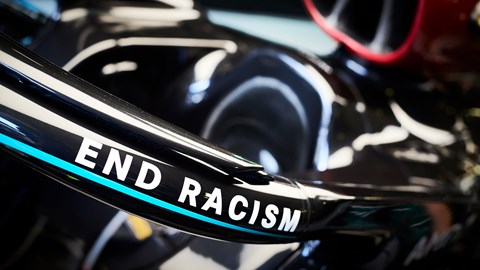
Getting there
With targets still a point of discussion at the moment, Mercedes is applying change in another way, using courses and education throughout the business to tweak the thinking and outlook of the existing workforce. It’s this push along with yet to be announced plans that the black W11 stands for.
‘We’ve formed an internal group to create a forum for talking about diversity, and the experience of team members from minority ethnic backgrounds,’ Lord explains.
But it’s also about tweaking the intake of the Mercedes F1 team and making it more attractive to people from varying backgrounds. With that in mind, the team will be setting up programs to encourage more people into F1, and recruitment processes are also being benchmarked externally.
‘Every manager who is in a position to recruit into the organisation has completed unconscious bias training. And we’re also rolling out a programme of inclusive leadership training as well,’ Lord adds. ‘So, lots of activity internally focused to upskill and improve or reinforce the awareness of other team members around, around the topics of inclusion, and with its focus on diversity of workforce.’

Focusing on STEM
Right now, the focus is on getting engineers of varying backgrounds into the team in addition to drivers. While Hamilton and Bottas might be the most visible members of the team, it’s the factory they thank after every win that has the most potential for change.
‘We’re encouraging people from non-traditional backgrounds into the right subjects and the right disciplines and the right specialisations that can then qualify them for, you know, the specialized technical roles that we have in the team.
Still, this doesn’t mean Mercedes isn’t looking for drivers from a range of backgrounds, too: Lord tells me the team already has a go-karter called Alex Powell, a cousin of the equally quick Jamaican 100m sprinter Asafa on its books…
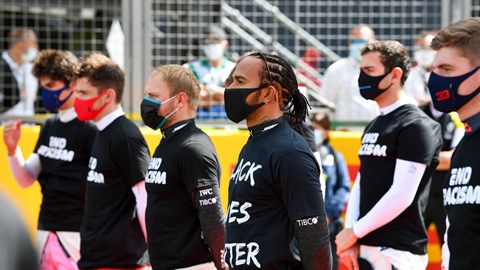
Keeping the Formula
But is this what F1 is about? Cars have changed throughout the years, from ground-effect wedges to the long, wing-laden race cars of 2020 – but F1 has always been about ultimate performance. It’s therefore understandable to ask what impact these changes will have in the most dominant F1 team the sport has ever seen – and how it impacts the F1 ethos.
Mercedes’ answer is simple; it’s still looking for talent, but in more areas than before. ‘It’s broadening our focus of target institutions rather than going to the same places that we have always gone to,‘ Lord explains. ‘So consciously broadening our search for talent in order to, put ourselves in the shop window for these people in a more proactive way.’
Since 2014, Mercedes has been praised from the outside for its open and blameless workplace culture – something in contrast to say Ferrari – and Lord thinks this new approach is simply an extension of that.
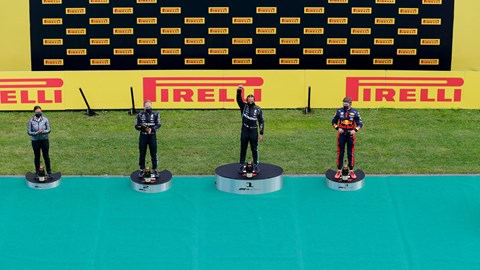
‘It’s absolutely aligned with our desire and determination to continuously improve to continuously strengthen. As a team we would say that we have an inclusive culture, that values every individual and encourages them to speak up.’
Although traditionally brought up in the context of engineering ideas, Mercedes’ focus on the individual now extends to inclusion.
What’s next?
Over the next few months, Mercedes will wrap up the constructors’ championship, and it’s very likely Hamilton will become a seven-time world champion. But what else will this odd, 2020 F1 season be remembered for?

We’re told the colour of the 2021 Mercedes-AMG F1 car will remain black – though it will look a bit different – but that’s not really important, more so is the fact Brackley is committed to the programme and ethos it’s currently putting in place.
F1 deserves its spot as a global sport, but its reach and its personalities such as Hamilton, Ricciardo and Norris means it’s also hugely influential, and thus has a responsibility to contribute to and support social issues. F1’s rich history is full of innovation – this feels like another leap, only this time it’s off the track.